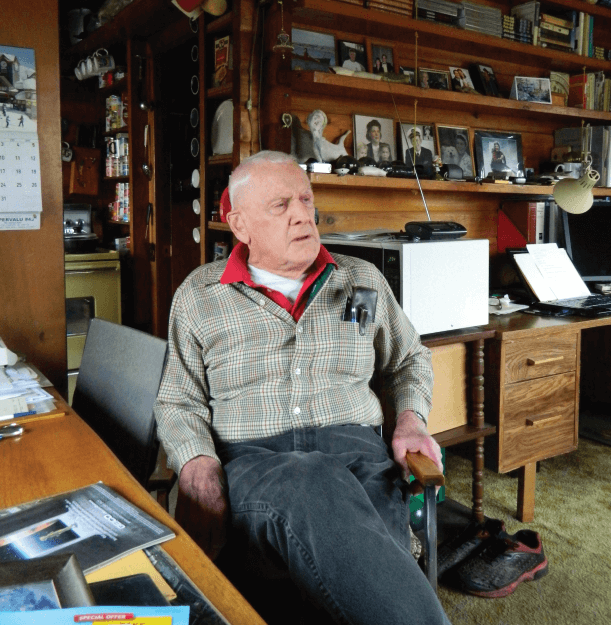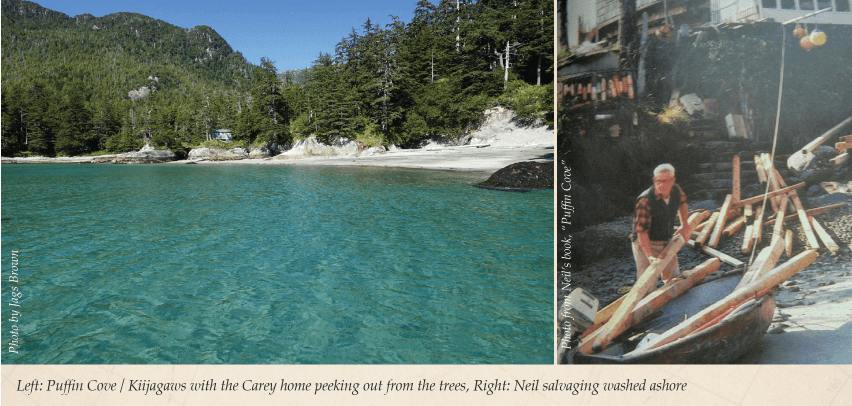| Sandspit’s Neil Carey Epic Life Adventures |
 |
| Written by Shellene Van der Beke |
| 16 March 2019 |
|
Light rain on my windshield wasn’t enough to dampen the promise of another, magnificent, misty isles day. The temperature was mild; even “warm” for this time of year. Passing St. Mary’s Spring, I saw sizable, blue-green, Hecate Strait swells turn into crashing waves that had me blurting out, “Whoa.” In Skidegate, I stopped off at Jags Beanstalk for one of their yummy chai lattes…and a couple of treats for Neil and I, including a cranberry scone. Excited, I mentioned my interview plans to barista aficionado, Jags. In a flash he dashed off and returned just as quickly with a copy of, “Puffin Cove – Escape to the Wilderness of the Queen Charlotte Islands.” Loaning me the book, he said, “Take a look at the photo section while you’re on the ferry.” Jags was right, the pictures of some of the Carey family’s endeavors were astounding. Neil welcomed me to his ocean side home with a friendly smile and sparkling eyes. The cozy, Lincoln Logs cabin has a lived-in feel and was built, for the most part, by his late wife, well-known author and dugout canoeist, Betty Lowman Carey, and their two sons in 1964. Grinning, I said to Neil, “Well I’ll be darned, this is the very same style of home that my husband, Ben, and I own in Port.” In the living room, Smithsonian and National Geographic magazines sit on a table beside a comfy reading chair and, other than a computer desk, there are more books, pictures and maritime mementos than anything else. Just inside the front door is a paper- strewn dining table pushed against the wall. Neil offered a cup of tea as the perfect accompaniment for our cranberry scone. With my recorder on, I enthusiastically anticipated hearing some of Neil’s stories. I was about to learn a great deal. Sixteen-Inch Guns Neil, now ninety-six years young, was born in Vermontville, Michigan in April 1922. His father, after serving as an American soldier in North Russia during WW1, was a history teacher and school superintendent. Every summer during the late 1920s and early 1930s, the Carey family took trips through the Eastern and Southern States, visiting historical sites. “We saw many forts, graveyards and statues of historical people, dating from the Revolution through the Civil War. It was educational.” Neil recalled. “Hotels were expensive and motels were rare. So, we erected a tent and camped nearly every night. Mother cooked our meal on a gas stove. Tires were not dependable, they’d blow out or get a puncture and Dad patched the tubes. Tires did not last like they do today. Gas was cheap. We had a restaurant meal once in a while, it was a treat.” Neil’s early travels, no doubt, are part of what influenced his love of the outdoors and seeing new places. After his dad retired from teaching, the family bought a 120-acre farm. Winters were miserably cold. Summers were hot. Neil decided farming was not in his future. His parents, both college graduates, wanted him to go to college, but to Neil, “School was a boring affair.” At age fifteen, he knew what he wanted to do: join the Navy and become a chief turret captain on a battleship with sixteen-inch guns. Talk about a clear vision for such a young fellow! After graduating and working on the farm for a year, Neil, now eighteen, convinced his parents to sign the papers allowing him to join the Navy.
Neil joined the US Navy in April 1940 as an Apprentice Seaman earning twenty- one dollars monthly and was sent to the U. S. Naval Training Station, Great Lakes, Illinois along with a few hundred other recruits. “Upon completion,” he shared, “I requested assignment to the USS Colorado, one of the navy’s three newest battleships commissioned after WW I. She had sixteen-inch guns. The Colorado was part of the US Pacific Fleet and our home port was Pearl Harbor, Hawaii.” Before Neil would be assigned to the turret, he had to work his way up, starting with mess cook duty and swabbing the ship’s teak decks. His pay was then thirty-six dollars per month. The Colorado was the only Pacific Fleet battleship not in Pearl Harbor when Japan attacked on December 7th, 1941, as she was in the Naval Shipyard in Bremerton, Washington at that time. “Dad fell out of the barn and broke ribs and a leg,” Neil said, “just before Colorado entered the shipyard, and I was given ‘Emergency Leave’ to go home for a few days to see Dad and help Mother on the farm. While returning to my ship in late November 1940 and awaiting my train at the Chicago Grand Central Station, a woman with a British-sounding accent approached and asked if I had been to Anacortes, Washington. I had not. Her name was Betty Lowman. A few minutes of talking revealed we were going to Seattle on the same train. “She was a Westerner…” Neil noted. “What do you mean by Westerner?” I asked. “Open in their conversations, ready for new experiences and not so snobbish as Easterners.”
Betty, equally as industrious as Neil, became a lecturer, touring on a regular schedule across the US. A polished speaker, Betty shared stories about the war, her famous rowing trip to Ketchikan, Alaska in her Indian dugout canoe, and being shipwrecked on a Nova Scotia island. Betty returned from her lecture tour before Christmas 1941. After thirteen months of conversations, letters and phone calls, Neil, nineteen and Betty, twenty-seven, married on December 26th, 1941. With his strong work ethic, Neil’s naval career progressed quickly. “While teaching gunnery at Farragut, Idaho, I was surprised to be promoted from Turret Captain First Class to Ensign, USN. By 1946 I was a Lieutenant (junior grade).” By 1953, Neil, now thirty-one years old, had been through WW II and the Korean War. Desiring to spend more time with Betty and their sons, George and Eugene, he resigned from active duty, but continued in the reserve for a total naval career of twenty-seven years. The Urban to Rural Shift Even in the early 1950s, Ventura County, California, where the Carey’s lived, had too much crime, population and smog for their liking. They dreamed of a simpler life. And so, in 1954, in search of a quiet, coastal bay to call their new home, Neil, Betty and the two boys, ten and eleven at the time, set out from Anacortes, Washington to circumnavigate Vancouver Island by boat. It was a nineteen-foot, east coast codfish dory called Thunderbird, powered by a used outboard engine. “That was 91 days,” Neil remembered, “but even in ’54, Vancouver Island looked too crowded for us.” The following year, in the same boat, all four again set out. This time they did a 120-day trip around the Queen Charlotte Islands/Haida Gwaii where they fell in love with a rugged but stunning lagoon on the west coast of Moresby Island. “From personnel in the Forestry office in Queen Charlotte City,” said Neil, “we learned it was possible to lease the lagoon, * and that is exactly what we did. Outside of getting married, it was the best decision we ever made. Later, we were given the honor and pleasure of naming this lagoon, Puffin Cove.” The Haida name for this magical place is Kiijagaws. Returning to California in 1955, Neil and Betty worked another ten years to save and invest enough to fund their next chapter. By June 1964, George and Eugene were in college. Neil and Betty entered Canada as “Summer Settlers” with a converted twenty-six-foot metal hulled lifeboat named Skylark. Their destination was Sandspit where they’d bought property, once a saw mill, to build a cabin on - the very same one Neil and I are sitting in, chatting and drinking tea. Their Sandspit home was to be their base while they boated back and forth building their long-awaited, off the grid, west coast dream.
After a couple of hours of storytelling, Neil suggested, “How about we go get some lunch?” I happily agreed. Driving his car (and impressing me with his driving skills for a man his age), he scooted us over to the Sandspit Airport’s Shingle Bay Bistro. As we both enjoyed a delicious bowl of soup, pretty much every person who walked by knew Neil and stopped to chat. Afterwards, Neil took me on a wee tour of Sandspit. By now, the sky had turned a stunning, clear-blue. “It’s a good place to live…quiet, peaceful and friendly,” Neil affirmed. He then stopped the car and pointed out Peter Grundmann and Nancy Robbins’ stackwall house. Their two-story home has 16 sides (so 32 walls in total), incorporating around 2000 colorful bottles and jars, some donated by Betty Carey from her west coast collections. We continued on to visit the current location of Skylark, its cabin removed, peacefully resting in the care of Gail Hoss. On the way back to Neil’s abode, we counted no less than sixteen eagles, both juvenile and mature, many perched atop shoreline trees, wings partially open, “Airing them to dry the feathers,” Neil noted. Awe-inspiring indeed. Back at the house, Neil continued sharing stories about his epic life adventures. “What time of year did you and Betty live out on the west coast,” I asked. “We spent winters there,” Neil responded, “…winter out there is simple, you stock enough supplies, so you don’t have to run back and forth all the time. Most people won’t believe it, but there are days, even weeks at a time, when it’s virtually flat. It’s not stormy all the time. We were close enough to the Pacific so there was not much snow. That was a nice place, a beautiful place. Betty would do her writing and eventually, for lack of something else to do, I did mine. There was a lot of work to be done. Just like now, I’m single, there’s a heck of a lot of work to be done…so many guys don’t realize how much a wife does!” I giggled and, while giving Neil a high five, proclaimed, “Thank you for saying that!”
Puffin Cove/Kiijagaws With supplies brought back and forth on Skylark, and some being delivered by a friend on a larger boat from Washington, Neil and Betty built a 216 square foot home on 3 spruce stumps and a salvaged timber, accessible through a trap door in the floor, for themselves and their two Samoyed dogs, Ivan and Sitka. The upper level had a double bed, a table, where Betty did her researching and writing, and a stainless-steel stove for heating and cooking. The lower level, added later, with windows on three sides, was a second writing room and, as Neil described, “I had an oil stove for heating and a Coleman gas stove for boiling coffee and cooking some food.” “We had no communications,” Neil added, “until about the last 4 years. We did have an AM radio and could pick up Prince Rupert by day and usually San Francisco at night.”
Supplies were often purchased at Tasu, the bustling, 400-person mining town built in the 1960s, closed and demolished in the 1980s. It was a four-to-fivehour trip north in Skylark if weather was good. The employees and their families in Tasu were the Carey’s nearest neighbors. Occasionally, either Neil or Betty chartered a flight, more frequently they caught a free ride to or from Tasu on a helicopter or floatplane if the pilot was heading back or forth from Sandspit empty. Neil noted that their cabin, which they never locked, was always stocked with adequate food and fuel to aid survivors or hikers. They know of two individuals who lost their kayaks when entering Puffin Cove, found food and shelter, rested and made it across the mountains, and were rescued. Another time they rescued an overdue hiker. “Life was delightful there,” Neil recalled. “During the fiercest of winter storms, when the Pacific raged, it sent great columns of water over the hundred- and fifty-foot rocks protecting Puffin Cove/Kiijagaws, to tumble down with force enough to break mature spruce trees. And we watched other wild waves jet more than halfway up the four-hundred-and-ninety-foot rock which offered some shelter to the bay outside.” Neil told me of the time he and Betty sat high on the stony outer beach watching large bundles of valuable, straight-grained, knot-free yellow cedar and other lumber smash ashore along with twelve by twelve timbers up to forty-four feet long. A few of these wooden missiles came shooting directly into the rocks, were caught standing upright, and then easily snapped by the next crazed wave. The crew and ship who lost that deck cargo survived to return to Vancouver and reload. “What was the most memorable thing you or Betty found?” I asked. Neil laughed, “A shiny, unopened two pound can of Chase & Sanborn coffee in the drift logs - and we were OUT! Been out for three days.” In September 1993, the Carey’s reluctantly departed Puffin Cove/Kiijagaws. They left behind their beloved cabin stocked with furniture, wood stoves, food, magazines, books, and eating equipment. Neil was seventy-one and Betty, seventy-nine. “We realized age was overtaking us, and we’d had plenty of experience with unfriendly seas that could disable or kill one or both of us,” Neil shared. “We had enjoyed more years than most individuals. We were out there for our own pleasure and never wanted anyone to risk their life looking for us…we quit while we were still ahead.” Formidably, Neil and Betty lived their bold and adventurous west coast lives for, on and off, almost thirty years. Neil, of course, misses Betty deeply. “She was an excellent seawoman, a fine, outstanding person. She could do so much; knew so much; taught me so much and knew what it was like to do without,” he proudly said. “She was good with boats. I was so lucky to have married her.” They were married just shy of seventy years. 
Words of Wisdom I asked Neil what advice he’d like to share with younger folks and he quickly replied, “Get to work. A menial job is better than no job. You’ll learn something including how to work and get along with others. You have to earn your way. Don’t expect everything to be given to you. I don’t believe there’s anyone you can’t learn something from, no matter what age, education or wherever they come from. No smoking. No drinking. Lots of exercise.” Nodding, I said, “Makes for good health.” “Yes,” Neil replied, “and it will keep you out of trouble.” “If you could do it all over again, what would you do differently?” I inquired. “I would let my dad know he wasn’t as dumb as I thought he was.” He then recalled when he was a rather spunky and smart kid, he advised his 80-yearold Grandpa Eugene, a farmer, that replacing his three teams of horses with a tractor would be more efficient. His grandpa, wholeheartedly disagreeing, responded by saying, “You can’t raise gas to feed it and you don’t get manure for fertilizer.” There is a good amount of truth to the notion that the simple life is where it’s at. Even at 96, Neil continues to write and to live an active life. Truly inspirational. A few days later, while gathering firewood with Ben in a rare Haida Gwaii snowstorm, I suddenly had a burst of energy and flipped over some logs in order to get them closer to the truck. In my mind, I was thinking about Neil and Betty, and I said to myself, “If they can do it, so can I.” Their many years of hard work and out of the box adventures have inspired my soul. Maybe yours too? To read more about Neil and Betty’s enterprising endeavors, their books can be purchased on Amazon.ca * For those who might be intrigued by residing on the west coast of Haida Gwaii like Neil and Betty did, it is important to note that the type of lease they received is no longer obtainable. According to Mark Salzl, Haida Gwaii Natural Resource District Authorizations Officer, “Residential tenures are now only available if associated with another project like a remote power facility, lighthouse or approved mining operation.” |





 It was a lovely late January, early morning drive. Following several recommendations, I was off from Port Clements (Port) to Sandspit to interview Neil Carey.
It was a lovely late January, early morning drive. Following several recommendations, I was off from Port Clements (Port) to Sandspit to interview Neil Carey.



 Their property was blessed with a creek meandering through it, that served as the basis for a gravity and siphon water system. The water ran through a five-gallon bucket filled with stones holding the intake end of a long three-quarter inch water hose. If the water stopped running at the cabin, Neil knew that a small fish must have found its way into the bucket and got stuck in the hose! For hot water, they boiled a kettle on one of their three stoves, and for light they had two gasoline lanterns. One for Betty, and one for Neil. Their toilet, in another building about ten feet away from the cabin, had a flush toilet (the only one between Tasu and Cape St. James!). A large metal bathtub with a full-length window above, offered the bather a majestic view of the cove. The tub also served for washing clothes. The room was kept toasty warm by a horizontal wood burning barrel that heated a vertical water-filled drum. The room served as a sauna and a place to dry clothes. In season, Betty tended a four by eightfoot garden filled with chives and a few flowers. Their food staples included eggs, peanut butter, canned chicken, canned bacon (very tasty from Denmark), canned butter and canned fruit. Yes, canned bacon and butter! Of course, they caught and ate an abundance of fish - red snapper being their favorite - and hunted venison to round their meals out. “We never shot deer in Puffin Cove/Kiijagaws, they were our neighbors and might climb onto the porch and peek in the windows.” When asked what he and Betty did for fun, Neil described hiking various shores, “Days when the Pacific was calm enough, we’d go beachcombing, maybe a few hours, perhaps for days, even a week just cruising around the islands with my cameras. There was always something new to find or see besides fishing or hunting for food.”
Their property was blessed with a creek meandering through it, that served as the basis for a gravity and siphon water system. The water ran through a five-gallon bucket filled with stones holding the intake end of a long three-quarter inch water hose. If the water stopped running at the cabin, Neil knew that a small fish must have found its way into the bucket and got stuck in the hose! For hot water, they boiled a kettle on one of their three stoves, and for light they had two gasoline lanterns. One for Betty, and one for Neil. Their toilet, in another building about ten feet away from the cabin, had a flush toilet (the only one between Tasu and Cape St. James!). A large metal bathtub with a full-length window above, offered the bather a majestic view of the cove. The tub also served for washing clothes. The room was kept toasty warm by a horizontal wood burning barrel that heated a vertical water-filled drum. The room served as a sauna and a place to dry clothes. In season, Betty tended a four by eightfoot garden filled with chives and a few flowers. Their food staples included eggs, peanut butter, canned chicken, canned bacon (very tasty from Denmark), canned butter and canned fruit. Yes, canned bacon and butter! Of course, they caught and ate an abundance of fish - red snapper being their favorite - and hunted venison to round their meals out. “We never shot deer in Puffin Cove/Kiijagaws, they were our neighbors and might climb onto the porch and peek in the windows.” When asked what he and Betty did for fun, Neil described hiking various shores, “Days when the Pacific was calm enough, we’d go beachcombing, maybe a few hours, perhaps for days, even a week just cruising around the islands with my cameras. There was always something new to find or see besides fishing or hunting for food.”



